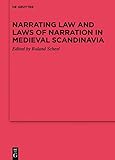Narrating Law and Laws of Narration in Medieval Scandinavia / ed. by Roland Scheel.
Material type: TextSeries: Ergänzungsbände zum Reallexikon der Germanischen Altertumskunde ; 117Publisher: Berlin ; Boston : De Gruyter, [2020]Copyright date: ©2020Description: 1 online resource (X, 293 p.)Content type:
TextSeries: Ergänzungsbände zum Reallexikon der Germanischen Altertumskunde ; 117Publisher: Berlin ; Boston : De Gruyter, [2020]Copyright date: ©2020Description: 1 online resource (X, 293 p.)Content type: - 9783110654219
- 9783110662320
- 9783110661811
- 340-349
- PT7321+
- online - DeGruyter
- Issued also in print.
| Item type | Current library | Call number | URL | Status | Notes | Barcode | |
|---|---|---|---|---|---|---|---|
 eBook
eBook
|
Biblioteca "Angelicum" Pont. Univ. S.Tommaso d'Aquino Nuvola online | online - DeGruyter (Browse shelf(Opens below)) | Online access | Not for loan (Accesso limitato) | Accesso per gli utenti autorizzati / Access for authorized users | (dgr)9783110661811 |
Frontmatter -- Foreword -- Contents -- List of Contributors -- Narrating Law and Laws of Narration: Introduction -- Part A. Narrating Law: Legal Texts – Narrative Texts – Contexts -- Chieftains and the Legal Culture in Iceland c. 1100–1260 -- Making King Hákon Great Again: Law, God, Morality and Power in Björgvin, 1223 -- Law Personified. The Ignored Climactic Speeches of Brennu-Njáls saga -- Part B. Laws of Narration: Narratological Approaches -- Court Poetry: Assemblies and Skaldic Verse -- What is ‘Good Law’? Law as Communal Performance in the Íslendingasögur -- Revenge or Settlement? Law and Feud in Early Sagas of Icelanders -- Part C. Narrating Law: Discourses on Social Norms -- Berserks Behaving Badly: Manipulating Normative Expectations in Eyrbyggja saga -- Social and Diegetic Hierarchies in Cases of Thievery. A Study of Mǫðruvallabók -- Part D. Narrating Law: Mythological Traditions -- Feudal Law and Archaic Order: The Discussion of Different Social Systems in the Queens’ Dispute in the Nibelungenlied -- History or Idea? The Legendary Laws of Old Norsemen -- Vǫlundr – a Gateway into the Legal World of the Vikings -- Týr, Fenrir and the Brísingamen. Tales of Law, Crime and Violence in Eddic Mythology and their Indo-European Subcontexts -- Name Index -- Place Index
restricted access online access with authorization star
http://purl.org/coar/access_right/c_16ec
Disputes lie at the heart of the sagas. Consequently, literary texts have been treated as sources of legal practice – narrations of law – while the sagas themselves and the handling of legal matters by the figures adhere to ‘laws of narration’. The volume addresses this intricate relationship between literature and social practice from the perspective of historians as well as philologists. The contributions focus not only on disputes and their solution in saga literature, but also on the representation of law and its history in sagas and Latin historiography from Scandinavia as well as the representation of laws and norms in mythological texts. They demonstrate that narrations of law provide an indispensable insight into legal culture and its connection to a wider framework of social norms, adjusting the impression given by the laws. The philological approaches underline that the narrative texts also have an agenda of their own when it comes to their representation of law, providing a mirror of conduct, criticising inequity, reinforcing the political and juridical position of kings or negotiating norms in mythological texts. Altogether, the volume underlines the unifying force exerted by a common fiction of law beyond its letter.
Issued also in print.
Mode of access: Internet via World Wide Web.
In English.
Description based on online resource; title from PDF title page (publisher's Web site, viewed 25. Jun 2024)


